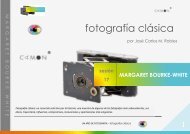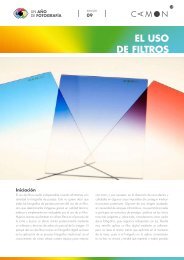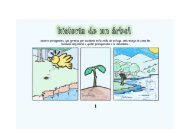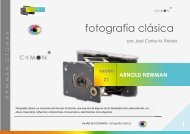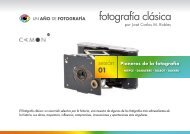Erfolgreiche ePaper selbst erstellen
Machen Sie aus Ihren PDF Publikationen ein blätterbares Flipbook mit unserer einzigartigen Google optimierten e-Paper Software.
<strong>Gal</strong>. <strong>la</strong> <strong>Uriol</strong> <strong>Jané</strong><br />
1
<strong>Gal</strong><br />
Koordinaten und Simu<strong>la</strong>kren<br />
. <strong>la</strong> <strong>Uriol</strong> <strong>Jané</strong>
Ein Laboratorium der Dinge. Neue Werke von <strong>Gal</strong> . <strong>la</strong> <strong>Uriol</strong><br />
In einem Raum mit den Werken von <strong>Gal</strong> . <strong>la</strong> <strong>Uriol</strong>: Der Betrachter ist<br />
verwirrt, fühlt sich überfordert angesichts der zahlreichen und gleichermaßen<br />
unterschiedlichen Bilder und Objekte, die ihn umgeben.<br />
Große und kleine Formate hängen da in sonderbaren Konstel<strong>la</strong>tionen.<br />
Die Augenhöhe des Betrachters ist nicht das Maß dieser Dinge. Es<br />
geht drunter und drüber – und dennoch wäre es ganz unrichtig zu behaupten,<br />
dass an den Wänden b<strong>la</strong>nkes Chaos herrschte. Da ist eine<br />
Ordnung, eine abstrakte. Vielleicht am ehesten vergleichbar mit der<br />
alphabetischen Reihenfolge, in der ein Lexikon den Bestand seiner<br />
Dinge versammelt und sortiert. Zwischen einem Aal und einem Abt<br />
gibt es außer dem gemeinsamen Anfangsbuchstaben tatsächlich keinen<br />
Zusammenhang. Die Dinge bleiben innerhalb des alphabetischen<br />
Gefüges ihrem Wesen nach unvermittelt nebeneinander stehen.<br />
Hier hängt das kleine Bild (Seite 13), in dem <strong>Gal</strong> . <strong>la</strong> <strong>Uriol</strong> ihre Lust an<br />
p<strong>la</strong>stischer Modellierung an einer eigenartigen Mischfrucht auslebt.<br />
Sie ist zweiansichtig und in feinen Graunuancen gegeben. Die obere<br />
Hälfte ist eine Quitte, die untere ähnelt einem Granatapfel. Die Frucht<br />
füllt das Format gänzlich aus. Ein wunderschönes Bildding ist da geschaffen<br />
– ein köstliches Stück Malerei.<br />
Dort befindet sich ein ebenso kleines Hochformat (Seite 13) völlig<br />
anderer Natur. Ins Auge fallen geometrische Strukturen: Ein Grund<br />
aus schwarzen und weißen Streifen, unterbrochen von einer grauen<br />
Fläche, darauf eine hellgrüne Form, die an ein aufgesch<strong>la</strong>genes Buch<br />
denken lässt. Die breitgezogene Raute, welche unter der grünen Form<br />
haftet und diese parallel zu ihrer oberen Begrenzung abschließt,<br />
nimmt die schwarzen und weißen Streifen des Grundes wieder auf.<br />
Dies bewirkt, dass die mittige Kante der grünen Fläche stetig hervor<br />
und zurückspringt und derart den Blick des Betrachters irritiert. Ein<br />
charmanter optischer Trick.<br />
Ein Stück weiter eine mittelgroße Leinwand (Seite 15), etwas breiter<br />
als ein Quadrat. Ein atmosphärischer Raum tut sich auf: Lebendiges<br />
Grau. Zarteste Nuancen Mauve und B<strong>la</strong>u schimmern in zwei horizontalen<br />
Ebenen ent<strong>la</strong>ng der vertikal abgezogenen Oberfläche hervor.<br />
Der ruhigen Gestimmtheit, die dieses Bild erzeugt, ist nicht zu entgehen.<br />
Man ist beeindruckt und erstaunt im selben Moment, weil es im<br />
ganzen Raum kein zweites Gemälde gibt, das in vergleichbarer Weise<br />
atmosphärisch wirksam ist.<br />
Etwas völlig anderes passiert, wenn wir den drei großen Landschaftsansichten<br />
(Seiten 22 und 23) dort drüben gegenüberstehen, die den<br />
Blick auf einen markanten Berggipfel von einer saftig grünen Anhöhe<br />
mit Bäumen aus eröffnen und variieren. Der Titel verrät, dass es<br />
sich um den Mont SainteVictoire handelt – jenen Berg, den Paul<br />
Cézanne so viele Male ins Bild gebracht hat. Da ist einmal das pure<br />
Motiv, ein Idyll, dem man aufgrund seiner pittoresken Erhabenheit<br />
als Betrachter unweigerlich Vorbehalte entgegenbringt. Doch schon<br />
beginnt die zweite Tafel, es zu destrukturieren: Etwas rechts von der<br />
Mitte, wo der Gipfel aufragt, schneidet <strong>Gal</strong> . <strong>la</strong> <strong>Uriol</strong> das Motiv vertikal ab<br />
und lässt es entsprechend der linken Seite von Neuem beginnen. Der<br />
»einmalige« Anblick wird verdoppelt und gerät zur formalen Sequenz.<br />
Auf der dritten Tafel wird das Idyll vollständig demontiert: Der b<strong>la</strong>ue<br />
Gipfel und die saftig grüne Anhöhe enttarnen sich als aufk<strong>la</strong>ppbare<br />
Pappkulissen. Deutlich erkennen wir die Faltungen. Zudem werden an<br />
den Hangseiten des Berges Falzstreifen sichtbar, wie man sie etwa<br />
von den ausschneidbaren Papierkleidern einer Anziehpuppe kennt.<br />
Die Malerin bricht das idyllische Motiv überdeutlich auf. Aber geht<br />
es hier tatsächlich um die längst verdaute modernistische Erkenntnis<br />
eines René Magritte, der in seinen Bildern nicht müde wird zu sagen,<br />
dass es der Betrachter dabei nicht mit der Realität, sondern mit der<br />
eigenständigen Wirklichkeit eines Bildes zu tun hat? Weit gefehlt.<br />
Nicht die modernistische Erkenntnis, sondern die amüsierte Reflexion<br />
über diese Erkenntnis ist Gegenstand der drei Landschaftsansichten.<br />
Die ziemlich ernsthafte Frage nach den postmodernen Möglichkeiten<br />
der Malerei verwandelt die Künstlerin in eine offensiv heitere Versuchsanordnung.<br />
Und immer wieder begegnet uns eine vertikale Streifenstruktur, die<br />
unaufhaltsam große und kleine Bildwelten durchfährt und gleichsam<br />
mit ihnen verschmilzt. Sie schafft eine räumliche Bezugsebene. Es<br />
entsteht ein Davor, ein Dahinter und ein Dazwischen. Manchmal erscheint<br />
die Struktur wie ein Vorhang aus vertikalen Lamellen, der<br />
den Blick auf eine metaphysische Welt im selben Moment zeigt und<br />
verbirgt. Manchmal werden die Streifen auch zu einem Gerüst, durch<br />
das sich schwarze Linienkonstrukte, farbige Flecken und merkwürdige<br />
Kritzeleien spreizen. Je nachdem, welches dieser Bilder wir betrachten,<br />
überwiegt entweder der ordnende, ja ornamentale Charakter der<br />
Streifen, welcher der Komposition Halt verleiht, oder ihr störendes<br />
Potenzial, welches die motivische Unversehrtheit untergräbt. Ein irritierendes<br />
Schwanken zwischen Affirmation und Skepsis – bewirkt<br />
durch ein und dieselbe bildnerische Struktur.<br />
Abermals anders verfahren die kleinen, an der Wand angebrachten<br />
Objekte aus farbiger Knetmasse (Seiten 40 und 41). Erst beim zweiten<br />
Hinblicken wird k<strong>la</strong>r, dass es sich dabei um p<strong>la</strong>stische Raumansichten<br />
in Miniaturgröße handelt. Steht man in einiger Entfernung vor ihnen,<br />
erscheinen sie nämlich so f<strong>la</strong>ch wie ein Gemälde. Es handelt sich um<br />
orthogonale Gebilde, gebaut aus drei Ebenen, die wiederum in grellen<br />
farbigen Streifen schillern. Mit jedem Schritt nach vorne und zu den<br />
Seiten verändert sich die Ansichtigkeit des Objekts und damit auch<br />
sein reales Aussehen. Auch werden die Spuren sichtbar, welche die<br />
Fingerkuppen der Künstlerin beim Festdrücken auf der Knetmasse hinter<strong>la</strong>ssen<br />
haben. Die Objekte sind reizvoll und verlockend. Man möchte<br />
sie berühren und ausprobieren wie ein kostbares Spielzeug.<br />
<strong>Gal</strong> . <strong>la</strong> <strong>Uriol</strong> ist in ihrer künstlerischen Arbeit daran gelegen, immer<br />
wieder von Neuem zu beginnen, mit jedem Werk andere Fragen zu<br />
beleuchten, die an dem großen Geheimnis »Was ist Kunst?« rühren.<br />
Ihre Arbeiten <strong>la</strong>ssen sich als Experimente begreifen, deren Ausgang<br />
sie mit großer Lust erprobt. Sie folgt einer eigenwilligen Versuchsanordnung.<br />
Dabei entsteht ein Laboratorium der Kunstdinge, das sich<br />
stetig erweitert. Querverbindungen werden sichtbar. Nicht das Eine,<br />
Absolute zählt, sondern das Viele, Vielgesichtige und Ungelöste.<br />
2 3<br />
Katrin Dillkofer
A <strong>la</strong>boratory of things. New works by <strong>Gal</strong> . <strong>la</strong> <strong>Uriol</strong><br />
In a room with the works of <strong>Gal</strong> . <strong>la</strong> <strong>Uriol</strong>: the viewer is confused, overwhelmed<br />
by the numerous and diverse paintings and objects that<br />
surround him. Large and small formats are arranged in peculiar constel<strong>la</strong>tions.<br />
The viewer’s eye level is not the ordering principle here.<br />
In fact there does not appear to be any ordering principle at all – and<br />
yet it would be wrong to say that utter chaos reigned on these walls.<br />
There is order here, but an abstract order. Much like the alphabetic<br />
order in which a dictonary assembles and arranges its verbal assets.<br />
Apart from the first letter, an aardvark and an abbot have nothing in<br />
common. In their alphabetic arrangement, things stand unconnected<br />
side by side.<br />
Here’s a little painting (p. 13) of a strange hybrid fruit, an expression<br />
of <strong>Gal</strong> . <strong>la</strong> <strong>Uriol</strong>’s passion for modelling in three dimensions. The fruit<br />
is shown from two perspectives in subtle shades of grey. Its upper<br />
half is a quince, the lower resembles a pomegranate. The fruit fills<br />
the canvas entirely. With it she has created a wonderful imaginary<br />
object – a delicious piece of painting.<br />
There’s also a small, tall painting (p. 13) of a completely different<br />
nature. The viewer is struck by geometrical structures: A b<strong>la</strong>ck and<br />
white striped background interrupted by a grey expanse with a lightgreen<br />
shape, reminiscent of an open book. This broad rhombus is<br />
attached to the lower edge of this grey expanse while their upper<br />
edges run parallel to each other. The b<strong>la</strong>ck and white stripes of the<br />
background are repeated here. As a result, the rhombus’s median<br />
edge appears to flip back and forth, thus irritating the viewer’s gaze.<br />
A charming optical illusion.<br />
A little further along in the exhibition we see a medium sized canvas,<br />
slightly broader than a square (p. 15). An atmospheric space opens<br />
up: Vivid grey. Gentle shades of mauve and blue shimmer in two horizontal<br />
<strong>la</strong>yers across the surface. The harmonious sense of calm<br />
generated by this painting is inescapable. The viewer is impressed<br />
and amazed at the same time, as no other painting in the room has a<br />
comparable atmospheric effect.<br />
Something completley different happens as we face the three <strong>la</strong>rge<br />
<strong>la</strong>ndscapes (p. 22–23), presenting variations on the view from a luscious<br />
green tree-lined hill to an impressive mountain peak. The title<br />
reveals this to be the Mont Saint-Victoire – the very mountain that<br />
Paul Cézanne was inspired to paint so many times. In one there is<br />
the pure motif, an idyll that the viewer spontaneously rejects because<br />
of its picturesque sublimity. But already the second tableau begins<br />
to deconstruct this: A little right of center, where the mountain top<br />
looms up, <strong>Gal</strong> . <strong>la</strong> <strong>Uriol</strong> introduces a vertical break, cutting the motif<br />
off, where upon it starts again from the left. The »unique« view is<br />
doubled and becomes a formal sequence. The third tableau seeks<br />
to deconstruct the idyll entirely: The blue peak and the luscious hill<br />
reveal them selves to be fold-away cardboard scenery. We clearly see<br />
the folds. On the mountainsides, we also see a seam of the sort familiar<br />
from the cut-out clothes for paper dolls. But is this really to do<br />
with the all-too-well digested modernist insight of René Magritte, who<br />
never tires of dec<strong>la</strong>ring in his paintings that the viewer is not seeing<br />
reality itself, but rather with the autonomous reality of the image? Far<br />
from it. Not the modernist insight, but the amused reflection on this<br />
insight is the subject matter of these three <strong>la</strong>ndscapes. The artist<br />
converts the rather serious question about the postmodern possibilities<br />
of painting to an offensively cheerful experimental set-up.<br />
Time and again we encounter a vertical structure of stripes travelling<br />
through worlds of images small and <strong>la</strong>rge, seeming to merge with<br />
them. This creates a level of spacial re<strong>la</strong>tion. It creates an In-front-of, a<br />
Behind, and an In-between. Sometimes this structure seems like a win-<br />
dow blind of vertical s<strong>la</strong>ts that simultaneously reveals and obscures<br />
the view of a metaphysical world. Sometimes the stripes become a<br />
framework, criss-crossed by constructs of b<strong>la</strong>ck lines, colour ful patches<br />
and strange scribblings. Depending on which painting we look<br />
at, the orderly, even ornamental character of the stripes that stabilizes<br />
the whole composition outweighs the stripes’ disturbing potential,<br />
which erodes the integrity of the motif. An infuriating oscil<strong>la</strong>tion<br />
between affirmation and scepticism – conjured by the same figurative<br />
structure.<br />
The small p<strong>la</strong>sticine objects mounted on the wall behave quite<br />
differently (p. 40–41). Only a second look reveals that these are in<br />
fact miniature interiors. Seen from a distance they seem to be f<strong>la</strong>t like<br />
a canvas. These miniatures are orthogonal formations, consisting of<br />
three <strong>la</strong>yers striped in bold, garish colours. Stepping up closer or<br />
to the sides changes not only the perspective on the object, but its<br />
actual appearance as well. Furthermore, the traces of the artist’s<br />
fingertips, left on the p<strong>la</strong>sticine while modelling, come into view. The<br />
objects are delightful and enticing. One would like to touch them and<br />
p<strong>la</strong>y with them like a precious toy.<br />
With every piece <strong>Gal</strong> . <strong>la</strong> <strong>Uriol</strong> begins again, finding new ways to explore<br />
different questions, all of which approach the great mystery of<br />
the nature of art. Her works could be regarded as experiments that<br />
she gleefully sets up according to her own idiosyncratic whims, just<br />
to see what will happen. The result is a steadily expanding <strong>la</strong>boratory<br />
of artful objects. Interre<strong>la</strong>tions reveal themselves. The important thing<br />
is not the singu<strong>la</strong>r and absolute but rather the varying, the manifold<br />
and the unresolved.<br />
Katrin Dillkofer<br />
Englisch von Hanna Engelmeier<br />
4 5
ZUSAMMENFASSUNG 2000 – 2006<br />
Lucio Fontanas Lächeln, Reißverschluss in Leinwand, 28 x 28 cm, 2000<br />
Garten, Mischtechnik, 24 x 24 cm, 2001<br />
Computer<strong>la</strong>ndschaft, Öl / Acryl / Leinwand, 30 x 40 cm, 2005<br />
6 7
DRUCKFEHLER – o.T., Öl / Leinwand, 30 x 25 cm, 2010<br />
o.T., Öl / Leinwand, 100 x 75 cm, 2010<br />
o.T., Öl / Leinwand, 30 x 40 cm, 2010<br />
8 9
o.T., Öl / Leinwand, 30 x 40 cm, 2009<br />
DRUCKFEHLER, Himmel und Wiese untereinander verknüpft,<br />
Öl / Leinwand, 30 x 50 cm, 2010<br />
Himmelstücke auf einer Wiese,<br />
Öl / Leinwand, 45 x 65 cm, 2009<br />
10 11
Fruchtmix, Öl / Leinwand, 25 x 30 cm, 2010<br />
o.T., Öl / Leinwand, 30 x 25 cm, 2010<br />
12 13
o.T., Öl / Leinwand, 22 x 28 cm, 2009<br />
o.T., Öl / Leinwand, 75 x 85 cm, 2009<br />
14 15
Jedes Werk: o.T., Wachskreide / Papier, DIN A2, 2010<br />
16 17
Legende, Öl / Leinwand, 30 x 40 cm, 2009<br />
18 19
DRUCKFEHLER – Kryptonische Dämmerung, Öl / Leinwand, 45 x 65 cm, 2010<br />
o.T., Öl / Leinwand, 50 x 70 cm, 2011<br />
20 21
Le Mont Sainte-Victoire III, Öl / Leinwand, 135 x 200 cm, 2009<br />
Le Mont Sainte-Victoire I, Öl / Leinwand, 70 x 100 cm, 2009<br />
Le Mont Sainte-Victoire II, Öl / Leinwand, 75 x 100 cm, 2009<br />
22 23
Digitalgemüse, Öl / Leinwand, 70 x 100 cm, 2009<br />
24 25
Inhalt oder Winter 2010, Öl / Leinwand, 100 x 75 cm, 2010<br />
Fallen, Öl / Leinwand, 275 x 200 cm, 2010<br />
26 27
DRUCKFEHLER – Du-und-Ich-Ressort III, Öl / Leinwand, 150 x 200 cm, 2009<br />
DRUCKFEHLER – o.T., Öl / Leinwand, 30 x 50 cm, 2011<br />
DRUCKFEHLER – o.T., Öl / Leinwand, 30 x 50 cm, 2011<br />
28 29
GEWICHT<br />
Schwerbe<strong>la</strong>stungskörper, Öl / Leinwand, 150 x 200 cm, 2011<br />
Das Kilo, Öl / Leinwand, 70 x 80 cm, 2008<br />
30 31
Koordinaten, Öl / Leinwand, 34 x 41 cm, 2009<br />
Côte d‘Azur, Öl / Leinwand, 75 x 100 cm, 2010<br />
o.T., Öl / Leinwand, 34 x 41 cm, 2009<br />
o.T., Öl / Leinwand, 45 cm x 65 cm, 2009<br />
32 33
Transparenz, Öl / Leinwand, 150 x 200 cm, 2009<br />
o.T., Öl / Leinwand, 40 x 30 cm, 2009<br />
o.T., Wachskreide / Papier, DIN A2, 2011<br />
o.T., Wachskreide / Papier, DIN A2, 2011<br />
o.T., Wachskreide / Papier, DIN A2, 2011<br />
34 35
Kristall oder Winter 2011,<br />
Öl / Leinwand, 100 x 75 cm, 2011<br />
o.T., Öl / Leinwand, 70 x 50 cm, 2011<br />
o.T., Öl / Leinwand, 46 x 38 cm, 2011<br />
36 37
o.T., Öl / Leinwand, 160 x 300 cm, 2011<br />
38 39
SKULPTUREN, DIE FLACH AUSSEHEN – Triptychon, Fimo auf Metallkern, 2011<br />
40 41
SKULPTUREN, DIE FLACH AUSSEHEN – o.T., Fimo auf Metallkern, 2011<br />
42 43
Loop, Druck auf Dibond P<strong>la</strong>tten, 2011<br />
44 45
o.T., grüner Teppich und Farbkarten, 2011<br />
<strong>Gal</strong> . <strong>la</strong> <strong>Uriol</strong> <strong>Jané</strong><br />
Geboren am 19. 07. 1978 in Barcelona<br />
Pizicato23@gmx.net<br />
www.gal<strong>la</strong>uriol.com<br />
90–91 / 92–93 Akademie Croquis, Studium der Zeichnung und der Malerei, Barcelona<br />
94–95 / 95–96 Akademie Leonardo da Vinci, Studium der Zeichnung und Malerei, Barcelona<br />
96–97 / 00–01 Studium der KunstTheorie und Malerei an der Design und Kunst Hochschule Eina, Barcelona<br />
97–98 / 00–01 Studium der Bildenden Kunst an der Barcelona Universität UB, Barcelona<br />
01–02 ErasmusStipendium an der UDK, K<strong>la</strong>sse Georg Baselitz, Berlin<br />
2003 Abschluss der Bildenden Kunst, UB, Barcelona<br />
2006 Abschluss an der Design und Kunst Hochschule Eina, Barcelona<br />
2011 Stipendium CAM, Caja Mediterraneo, A<strong>la</strong>cant, Spanien<br />
46 47<br />
Ausstellungen<br />
2002 Rundgang 2002, UDK, Berlin<br />
Tische und Karusselle, Einze<strong>la</strong>usstellung<br />
in der Acadèmia de Belles Arts de Sabadell, Sabadell<br />
2005 Modernitat líquida, Gruppenausstellung in der <strong>Gal</strong>eria Fidel Ba<strong>la</strong>guer, Barcelona<br />
2006 Projeccions, Einze<strong>la</strong>usstellung in der Cambra de <strong>la</strong> Propietat de Barcelona, Barcelona<br />
La mirada de <strong>la</strong> dona de Lot, Gruppenausstellung<br />
in der Sa<strong>la</strong> d´Art Jove de <strong>la</strong> Generalitat de Catalunya, Barcelona<br />
Marges i neu, Einze<strong>la</strong>usstellung in can Negre, Sant Joan Despí<br />
2007 Sputnik 2, Neue Malerei aus Berlin, Gruppenausstellung in der <strong>Gal</strong>erie C<strong>la</strong>udius, Hamburg<br />
Biennal de Valls, Valls Museum, Valls<br />
2008 30 gegen 3.000.000, Skulptur und Malerei aus Berlin, Gruppenausstellung im Kunstverein<br />
Schloss HolteStukenbrock, www.30gegen3000000.de<br />
Quest, Gruppenausstellung in der <strong>Gal</strong>erie Zern, Berlin<br />
2010 The Best of dimension 5, Gruppenausstellung in der <strong>Gal</strong>erie im Regierungsviertel /<br />
Forgotten Bar Project, Berlin<br />
Phantomschaltung, Gruppenausstellung im Fernmeldeamt Berlin Mitte, Berlin<br />
2012 Simu<strong>la</strong>kren, Einze<strong>la</strong>usstellung in der <strong>Gal</strong>erie cubusm, Berlin
48<br />
Impressum<br />
<strong>Gal</strong> . <strong>la</strong> <strong>Uriol</strong> <strong>Jané</strong><br />
Koordinaten und Simu<strong>la</strong>kren<br />
Fotos Jakob Zoche<br />
Martin Eberle<br />
Text Katrin Dillkofer<br />
Übersetzung Hanna Engelmeier<br />
Gestaltung Halina Muchow<br />
Druck Seltmann GmbH Druckereibetrieb, Lüdenscheid<br />
Copyright Bilder © <strong>Gal</strong> . <strong>la</strong> <strong>Uriol</strong> <strong>Jané</strong> 2012<br />
Copyright Text © Katrin Dillkofer 2012<br />
Für die Unterstützung bei der Entstehung der Skulpturen<br />
bedanke ich mich bei der CAM Obra Social, A<strong>la</strong>cant, Spanien.<br />
Für die Unterstützung bei der Realisierung des Kataloges<br />
bedanke ich mich bei der <strong>Gal</strong>erie cubusm, Berlin.<br />
Weiterer Dank an C<strong>la</strong>ra und Josep Maria, Daniel, Halina,<br />
Hanna, Holger und Peter, Ilya, Jakob, Katrin, Oskar.




